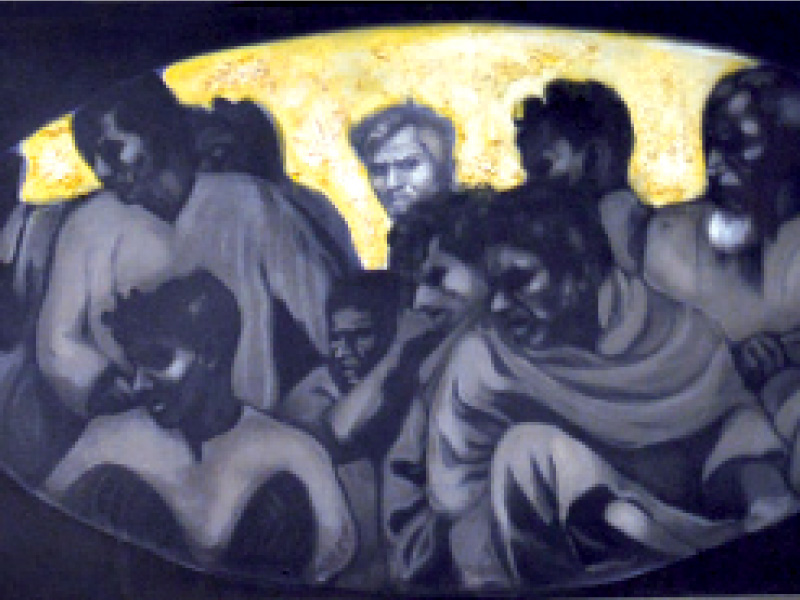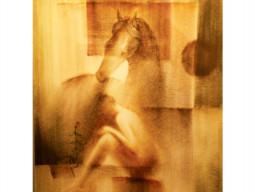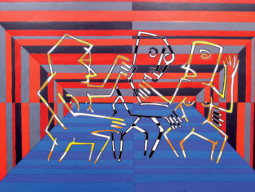
ISLAMABAD:
The transition to adulthood is one that pushes artists to explore the fleeting, tumultuous nature of existence and to retrace the past’s innocence through a lens of disillusionment.
A three-person show titled ‘The Man Who Wasn’t There’ opened at the Satrang Gallery at Serena Hotel on Monday and engaged audiences in an endearing conversation about the unrequited emotions that define the nature of being. A total of 17 pieces in various mediums lent a macabre sensitivity to viewers as the canvas and sculpture complemented the ambivalent narratives of National College of Art graduates, Suleman Aqeel Khilji, Ali Baba and Sajid Khan.

Khilji’s relationship with light is one that defines his body of work — its usage is dramatic and sacrosanct, evoking the histrionic strokes of master painters, Caravaggio and Rothko, though the 28-year-old’s imagery is a shift from the classical, employing nightmares, memories and images retained from photographic books and mass media.
“Our canvases are inextricably linked to our memories, as is our imagination. We recall the things we hear about and see and internalise them without even knowing it,” shared Khilji, who believes that his struggle to come to terms with the unrest within is one that translated into his canvas. Khilji’s work explores the transgression of dreams and reality and questions the idea of what is “pure and safe” through the use of halo-esque, Byzantine-art inspired light.

An untitled diptych in plaster, canvas and oil lifts its visual references from a photographic book about ancient India. Within the murky shadows of draped figures, a man’s face is half-lit and framed entirely in the kind of “white” that Khilji deems as both a “sign of transition from the old to new” and a depiction of “purity” and its validity.
Swat-born miniature artist Sajid Khan’s brooding canvases are rooted in experience. Regressing to graphite in an evocation of his childhood in his village where pencil was the only tool for expression, Khan’s process is subtractive. In his dreamy canvases that recall starry nights in open verandahs and clouds that came alive in shapes and letters, Khan explores the nostalgia of a secure and uncomplicated existence with his siblings.
“Clouds are creatures unconstrained by material boundaries, they cannot be comprehended in terms of shape, volume, space and size. In a sense, they reflect our non-material existence,” expressed the artist, whose childhood idealism shifted when Swat became the epicenter of terrorism and conflict. The cloud-watching frivolity of childhood took on greater symbolism: the dusty clouds of bombs and distant drones became the harbingers of fear and carnage.

Through a scavenger hunt at an old bookstall, Khan discovered a photographic book on the Second World War, further instigating the artist’s inner dialogue. His work then took on a universal precedence, as a body of work speaking for the new generation of children born into an unstable world.
Baba’s sculptures have a presence that is quiet and unassuming, unlike the darkness of Khilji and Khan. Using cement and plaster, the young artist embraces the idea of space, and a lack of through the visceral. One of his pieces titled “Rise” shows the elevated legs of a human floating within an acrylic sheet. “My work possesses pathos, perhaps a culmination of my experience of the surroundings,” shares Baba.
The show’s curator, Zahra Khan, believes in freedom to explore and it this search for deeper meaning that draws her to the artists’ work. “The artists are masters at their crafts, their work is full of energy, movement and meaning, and yet is presented simply and subtly.”
Published in The Express Tribune, October 23rd, 2013.


































































COMMENTS
Comments are moderated and generally will be posted if they are on-topic and not abusive.
For more information, please see our Comments FAQ